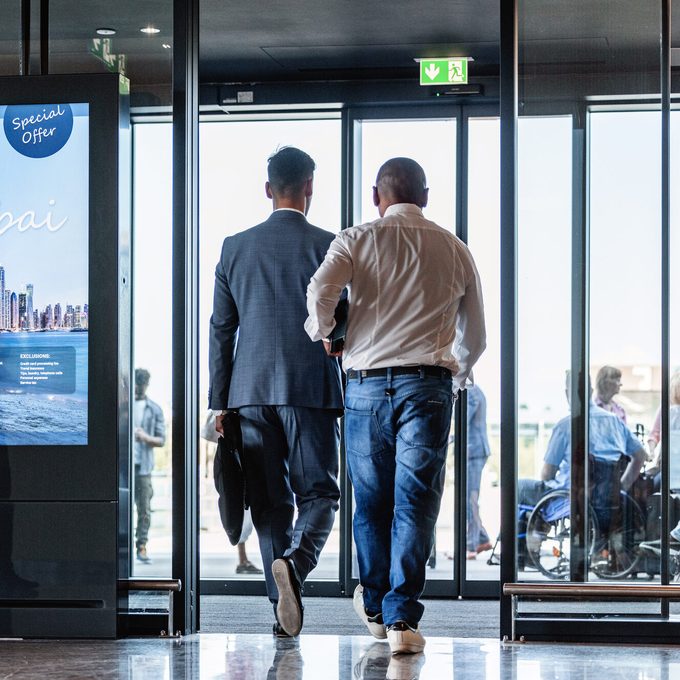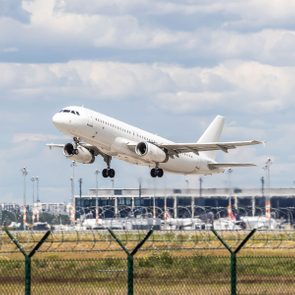A new style of airport doors may make you do a triple-take, but they're there for some very important reasons

Here’s Why You Have to Exit Through a Triple Set of Glass Doors at the Airport

I first noticed them at New York City’s JFK—those futuristic glass portals with multiple sets of doors that swing open and shut as you pass through, like a high-tech lock and dam. Without fail, every time I step inside them, I question whether the next set of doors will fail to open and I’ll end up trapped, flailing around like a rogue aquatic creature attempting to escape an aquarium. I’m happy to report that so far, I’ve never experienced such an anxiety-inducing scenario, nor have I ever heard of anyone else getting caught in that kind of claustrophobic chaos.
Still, I’ve noticed that these multitiered exits I once thought of as a JFK oddity are now popping up more and more during my travels. I’ve often wondered about the growing trend—and the real purpose—of these slow-moving, sci-fi-style doors. Are they meant to streamline passenger flow, or are they designed to serve some other purpose (besides worrying me)?
To find out, I reached out to someone in the know: Ken Ibold, the deputy director at Pensacola International Airport (PNS). Read on to find out what he had to say.
Get Reader’s Digest’s Read Up newsletter for more travel news, cleaning, tech and fun facts all week long.
Why do passengers exit through glass doors at the airport?
At PNS, where Ibold works, the multilayer portals are known as automated exit lanes. “We just installed some last year, freeing up a bunch of real estate that we use for peak demand checkpoint queuing,” Ibold says of the trending gateway. “They’re more efficient and much more secure than what we used to have there.”
How do they help keep airports secure?

Horton Doors, a major manufacturer of these portals, refers to them as security exit lanes, or SEL. According to Horton, the lanes, equipped with sensors, act as breach control, ensuring that pedestrian traffic can flow only in one direction—from the secure zones of the airport to nonsecure areas. “The SEL creates a physical barrier, detecting and preventing unauthorized entry, thus maintaining the natural flow of traffic,” the company notes on its website.
Ibold adds that TSA requires airports to maintain a secure barrier (essentially a checkpoint) between a concourse’s “sterile” gate area, where passengers have been screened, and the public-facing terminal, where unscreened people are allowed. “However, in the area where passengers leave the sterile side, the exit lanes must prevent people on the public side from going ‘upstream’ to the sterile side,” he says. “The automated exit lanes track the positions of individuals going through the lane, and if someone tries to turn around and go the wrong way, doors on the sterile side automatically shut, while the doors on the public side remain open.”
What if someone really wants to meet a family or friend in the exit area?
If you want to meet a loved one at their gate, please don’t be that person who believes they could or should beat the system. The automated exit lanes at PNS, for example, are tested regularly to ensure passengers flow in only one direction through exits. “Our tests and our operational experience have prevented unauthorized entry every single time,” Ibold says. “We haven’t had a single instance of [someone breaching the doors].”
Is security the only reason airports are switching to these multitiered exits?
Security is definitely a factor in airports increasingly adopting triple sets of exit doors, but it’s not the only reason. “Some exit lanes are staffed by TSA agents or airport security staff who are charged with preventing unauthorized entry,” Ibold says. “That staff must be present at all times the lane is not physically locked. That cost of personnel is the primary incentive to automate.”
There’s also the issue of space. “In our case [at Pensacola International Airport], we had an automated exit lane with much older technology that required more than five times the physical space,” Ibold says. “By converting to the new lanes, we were able to use that space more efficiently.”
Are triple exit doors a new development at airports?
While triple-doored exit lanes have been around for several years, Ibold says they’re quickly gaining traction. “The cost is reasonable considering it’s something of a niche product, and they are remarkably effective,” he says. In fact, at PNS, they’ve already reserved space to double their capacity. “That will be years from now—and technology will only improve—but it’s been a big win for us.”
So can my biggest fear actually happen? Could someone get stuck?
I have little to fear the next time I’m at the airport. Ibold reassures me that the automated exit lanes are designed to track passengers’ positions as they move through. “If someone tries to turn around and go the wrong way, doors on the sterile side automatically shut, while the doors on the public side remain open,” he says. “No one gets trapped in the lane.”
And if a passenger gets confused or becomes determined to reenter the sterile area? “There are recorded voice prompts instructing the person going the wrong way to exit the lane, and an alert is sent to the airport’s operations center so staff can monitor the situation and respond accordingly,” Ibold explains. And in the unlikely event of a total system failure, he adds, “We would revert to a staffed exit lane.”
About the expert
|
Why trust us
Reader’s Digest has published hundreds of travel stories that help readers explore the world safely, easily and affordably. We regularly cover topics such as the best places to visit (and the best times to visit them), tips and tricks to zoom through airport security, flight-attendant secrets, hotel-room hacks and more. We’re committed to producing high-quality content by writers with expertise and experience in their field in consultation with relevant, qualified experts. We rely on reputable primary sources, including government and professional organizations and academic institutions as well as our writers’ personal experiences where appropriate. We verify all facts and data, back them with credible sourcing and revisit them over time to ensure they remain accurate and up to date. Read more about our team, our contributors and our editorial policies.
Sources:



